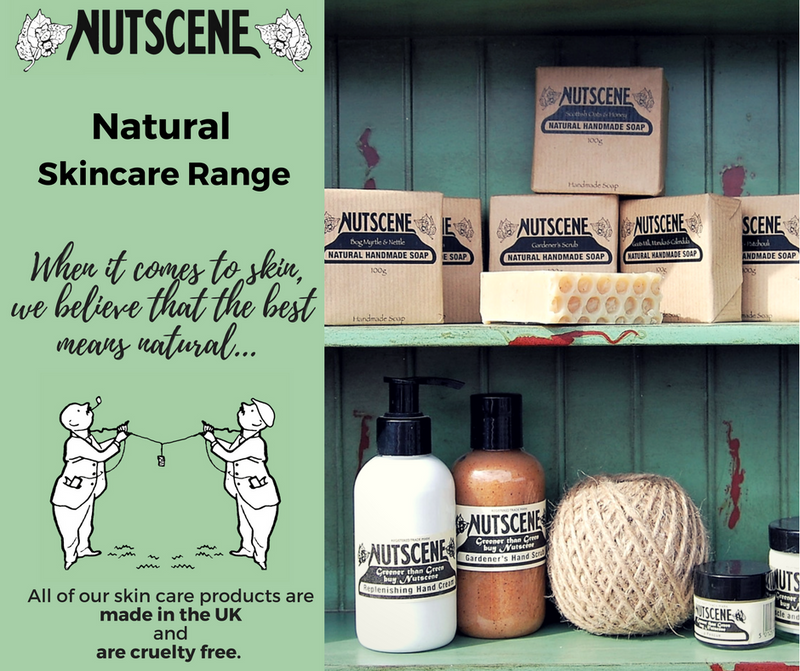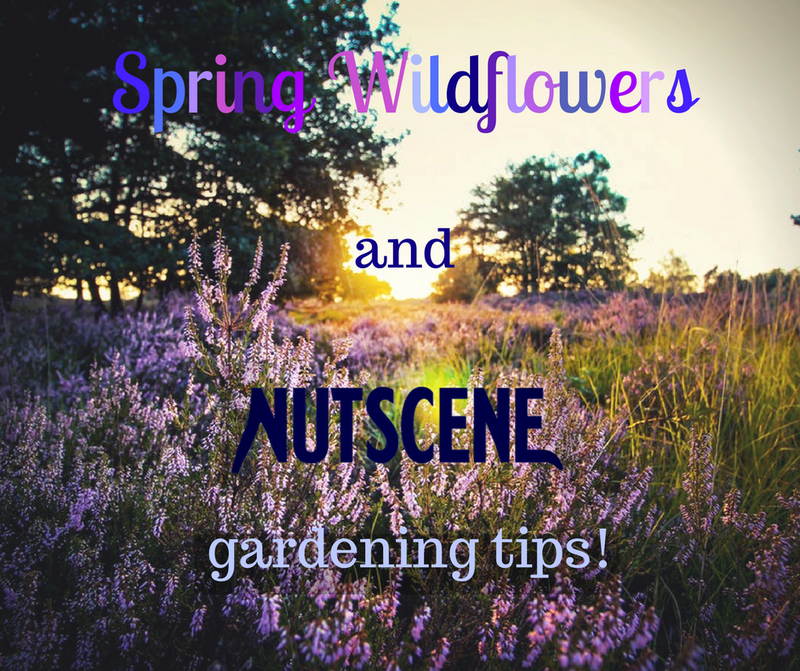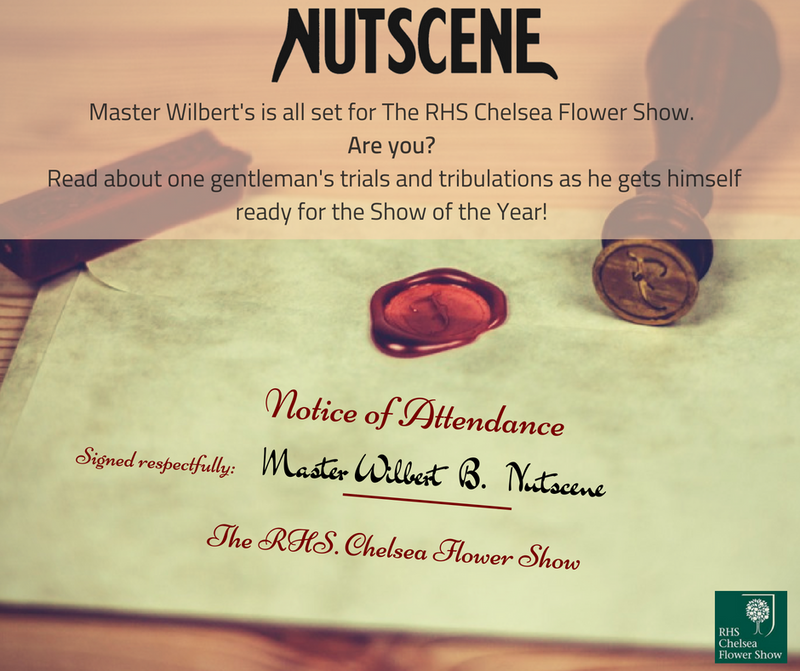
by Shona Young
Nutscene Natural Skincare Range
This blog focuses on the harmful effects of palm oil and discusses Nutscene's latest skincare range.

by Shona Young
Nutscene Natural Skincare Range
This blog focuses on the harmful effects of palm oil and discusses Nutscene's latest skincare range.
by Blue2 Digital Collaborator
Nutscene on Sustainability
This year (or for the past few at least), sustainability seems to be the word on everyone's lips... But what is sustainability and why is important to support the ever growing 'sustainable scene'? Nutscene investigate...

by Shona Young
Spring Wildflowers and Nutscene's gardening tips!
Spring is here! And there is nothing nicer than seeing the regrowth of greenery and the flowers starting to bud. This week, Nutscene are looking into Britain's favourite wildflowers. We are also including some tips and tools so you can get the best out of your gardens over the spring period (you can thank us later!) 1. Ramsons (Allium ursinum) Ramsons (also known as wild garlic) are often seen acting like a beautiful white carpet across many forest floors throughout the UK in Spring. Often you can smell the Ramsons' perfume before you see them! This plant prefers woodland and can often be found in the damper areas. Flowering usually takes place between April and June. Little tip: If you are going to cook with Ramsons, it is best to do so when the plant is young. Now that Spring is here, the real preparation needs to be made to ensure that your garden is fully ready for the delights of the warmer months. We recommend our Linen and Leather Gardeners Apron to ensure that you have all the right tools with you, when gardening season hits: Heritage linen and Leather Gardeners Apron Our handmade half length waist apron combines tough durable linen with our dark brown leather. Beautifully made in the UK, this quality apron is what every gardener is crying out for, allowing you to keep necessary tools and twine close whilst concentrating on the job in hand! Just perfect for storing your tools (or phone) with a secure zipped pocket. Size can be adjusted with a webbing waist strap and buckle. It's a super gift for any gardener, muted colours means it's ideal for the man or woman in your life. Click here for more information. As Spring approaches, it is often a good idea to go around your flower beds and paths to clear the area. Pruning the old growth and refreshing the soil can really help your garden get into shape for Spring. 2. Primrose (Primula vulgaris) This is another popular woodland flower that is admired during spring. This plant grows best in shaded spots and prefers moisture. This is one special plant, as it even has a day where it is celebrated across the UK - which is the 19th April in case you were wondering! Both the leaves and the flowers of primrose are edible. Fresh flowers are used in wine whereas dried leaves tend to be used in the process of tea making. Old english folk lore says that if a child eats a primrose that they may see a fairy! 3. Wild Daffodil (Narcissus pseudonarcissus) This is another spring favourite that gets a lot of attention! Often abundant in damp pastures or through woodland, these distinctively shaped flowers are appreciated each Easter. It is important to be careful with the watering of these plants, as over watering can result in the rotting of the bulbs. These plants also go by another name depending on where you are from - in England, they are often referred to as Lent Lillies. Daffodils are symbols for couples who are reaching their 10th year wedding anniversary. It is a known tale that presenting 1 daffodil to someone is a gesture of bad luck - so remember, always have more than one at the ready! As our favourite plants and flowers start to return to life again, sometimes these plants can get a mind of their own! Before you know it- they have grown arms and legs and are taking over their designated area. We recommend our Gardeners Gift Set to help you keep your growing greenery in check! Essentially Nutscene, Gardeners Gift set in Vintage Style Packaging A Gardeners essential gift set of practical and useful Nutscene products. Each set contains our Classic Nutscene Garden Twines in Green and Natural jute. The Greentwist Twine is 2 ply , 100 m in length, The Natural Twine is 3 ply 80 m in length. A set of four wooden plant labels, a mini dibber (Dibblet), and a pair of our vintage style flower snips. Click here for more information. Spring is the perfect time to potter about and to sort out some of the odd jobs. Do you have a plant support that has seen better days, a broken trellis -now is the time to fix this. It may also be a good idea to cordon off the area that you want specific plants to grow in this year. This can help you assess how the plants are developing as the year progresses. 4. Bluebell (Hyacinthoides non-scripta) These distinctively blue flowers are easily recognisable as a clear sign that Spring is here! Bluebells love shade and damp soil. If you keep your eyes peeled, you might spot a rare type of bluebells. This bluebell is white in colour because it lacks the blue pigment. When you next have the joy of slowly strolling past Bluebells growing in abundance, think of this - around half of the world's Bluebell population grows in Britain. There is a Bluebell myth that says if you were a wreath of Bluebells around your neck that you cannot tell a lie. Haws® Metal Indoor watering Cans Haws ® indoor metal cans are available in 3 colours. Supplied with a removable brass rose, making it a versatile indoor can for watering small plants, pots and seedlings. Handcrafted from powder coated steel in our 100 year old traditional shape & delivered in a Haws gift box. These cans are extremely practical for the home, conservatory or greenhouse... and what's more look beautiful. Click here for more information. It is the time to really get prepared, and making sure you had a good quality watering system in place is important. Many new flowers need lots of hydration. Also if you are intending on tackling some bald spots within your grass by planting some grass seed - remember that this will need substantial watering to help the seeds bed in! 5. Wood Sorrel (Oxalis acetosella) Wood Sorrel are recognised by their small white flowers. These plants enjoy woodland ground in shaded moist spots. These flowers can be identified by its three heart-shaped leaves. The Sorrel stems and leaves tend to have a tangy or sour lemon flavour. This plant is rich in Vitamin C and Vitamin A. Sorrel can be used to help a range of health issues such as a sore throat. Sorrel blooms during the spring and summer months. These flowers attract bees, butterflies and flies. As your flowers and plants really start to thrive, remember not to forget about them. They still need your love! It might be watering, dead-heading or just checking as to whether the insects have been attacking them - but don't leave them to their own devices! We hope you enjoyed this blog and some of our tips. Do you have a favourite wildflower that we didn't mention here? Let us know! Lots of Love, The Nutscene Team

by Shona Young
The Art of Macramé and we introduce "Mac-Cramy!®"
Macramé is having a serious moment in the spot-light right now and we, at Nutscene are loving it! Some trends are a simple flash-in-the-pan. 90s Platform shoes and the Harlem Shake spring to mind! However Macramé has a rich history that spans generations, oceans and continents. The Nutscene team took some time to find out more... A Brief History of Macramé It seems that there many different types and variations that all fit under the Macramé craft. Essentially Macramé is the creation of a textile through a knotting process. Back to the Start Where did Macramé come from? Well, there seems to be some controversy as to where this craft originated from. Some sources suggest that the craft originated from 13th century Arab weavers, whereas other records indicate that the craft initiated in China. It is believed that the art was then taken to Spain and from there spread across Europe. Records indicate that Macramé wasn't introduced to Great Britain until the 17th century. Ship-a-hoy! However it is generally accepted that sailors play an important part in the tale of Macramé. It seems the craft was widely used by sailors. With many hours on the sea, the sailors would create items such as rope ladders, hammocks, bags and belts. It is thought that European sailors in particular, helped with the spread of Macramé's popularity, by showcasing their crafts to the various lands that they traveled to. Perhaps even selling or bartering their Macramé craft in exchange for other items when they docked. A Victorian Manner Victorians also indulged in the craft, often with the particular aim of embellishing their homes. Homemaking was often encouraged in Victorian society and Macramé was seen as a respectable hobby for wives and daughters. The craft was fortified when members of the Royal family also gave it their approval. Moving on up! A huge revival was seen in the 1970s. You might have struggled to find a home in Britain in the 1970s that didn't have the obligatory macramé pot-hanger as featured in the picture below! There was a boom for books containing patterns and instructions on how to tackle macramé projects. Macramé was used to make wall art, clothing, table dressings, curtains, plant hangers, chairs... To say it was hugely popular - might be an understatement! Today Today, Macramé is back on in the world of fashion and design (Woohoo!). Macramé is being used in a wide sense- from home interiors to jewellery crafts. We are delighted to see Macramé plant and candles holders coming back in force. These can be beautiful to look at and instantly invite someone into a room. And as if you needed another reason to fall in love with a roof hanging plant holder - If you are like us, and have feline invaders in your home - it can be an ideal way to keep your plants up high or away from tables so they can't have a little chew! We think this kitty might be away to do just that! For the really ambitious, they can always try and tackle a macramé swing chair Seriously though, who wouldn't love an actual swinging chair in their home!? For those who prefer to walk before they can run.... a macramé bracelet could be the perfect place to start. At Nutscene, we love to support all our fans and friends in their projects. We are delighted to announce that we have released our very own Mac-Cramy Twine®. Our Mac-Cramy® twines are from 100% recycled cotton and come in either fine or thick twine - perfect for whatever project you decide to embark upon... We have gone for classic yet versatile colours: including chocolate brown, natural, black, dark blue, grey and mustard in 2 different sizes. Not sure where to start - Don't worry! There are a number of blogs and social platforms that offer really good tutorials or tips for getting started! In creating this blog, the Team at Nutscene read a wide collection of sources on the history and development of the craft of Macramé. Here are some really great sources that we read on the topic: http://macramebracelets.com/history-macrame http://www.ancientearthhealing.com/history-of-macrame/ http://macramecollective.com/news/?p=553 http://www.macramelovers.com/blog/macrame/origin-macrame-journey-world/ Lots of Love, The Nutscene Team

by Shona Young
To BEE or not to BEE? Nutscene look at getting bees back into UK gardens!
At Nutscene we love bees! This blog focuses on the tips for getting bees back into british gardens and highlights some of our best bee-related products.

by Shona Young
Wilbert's Notice of Attendance - The RHS Chelsea Flower Show 2018
Master Wilbert has been very, very busy preparing for The RHS Chelsea Flower Show... Find out exactly what Wilbert packed for the show, as well as where Wilbert can be found at the greatest flower show in the world!